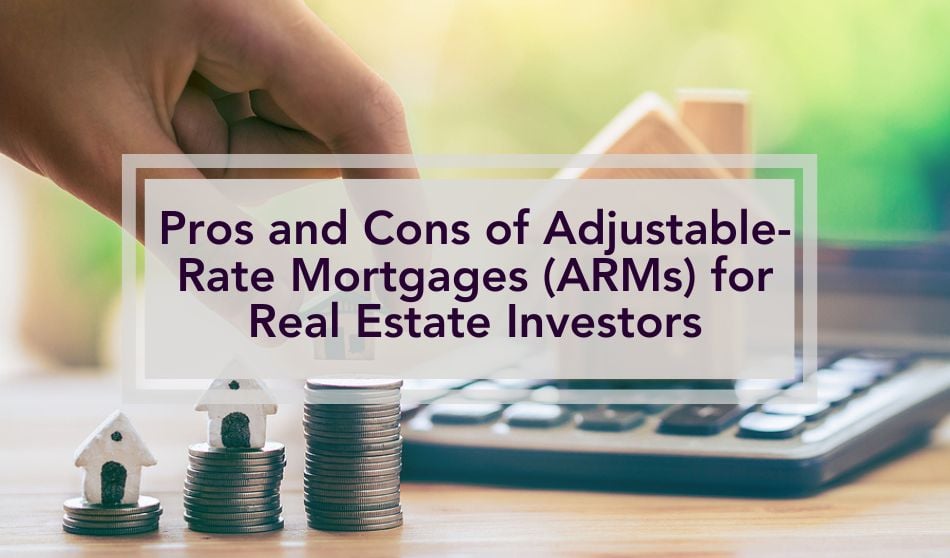
Understanding an ARM as a real estate investor is key to evaluating your options to grow your portfolio and long-term wealth. If you are thinking of seeking unconventional financing to build your portfolio, it’s vital to grasp the pros and cons of adjustable-rate mortgages before you take the leap.
Real estate investors don’t look at financing in the same way that homeowners do. Juggling loan options for multiple properties is much different than getting a single loan for the family home. Getting the best deal on your money is key when financing a real estate investment, and balancing the loan terms and conditions with a property’s potential profit might mean seeking unconventional financing. Enter the adjustable-rate mortgage.
What is an adjustable-rate mortgage (ARM)?
Most people are familiar with a conventional loan, which has a fixed interest rate that never changes over the loan’s life. On the other hand, an adjustable-rate mortgage is set to move up or down depending on various factors; the most common adjustments are made based on the Secured Overnight Financing Rate (SOFR).
The terms and conditions of an ARM are variable and can often be negotiated with a lender. Many loans are hybrid ARMS, where you pay only the interest for a fixed period before settling in to repay the principal.
Regardless of the terms, these loans come with one of three types of cap. These caps determine the maximum percentage by which interest rate increases can be set.
- Initial adjustment cap: The maximum first adjustment after the fixed interest rate period ends (usually 2%)
- Subsequent adjustment cap: Adjustments made after the end of the fixed-rate term (also often 2%)
- Lifetime adjustment cap: The maximum allowable increase across the life of your loan (generally no more than 5%)
Adjustable-rate mortgages are often advertised as a “5/1 ARM” or a “10/1 ARM.” The first number indicates the fixed interest rate period, and the second indicates the rate adjusts yearly. If you see a 5/6 ARM, the interest rate adjusts every six months.
Shorter overall repayment periods mean lower interest rates, but it’s essential to balance that attractive low rate with your projected ability to cover the payment when the rate resets.
Pros Of Adjustable-Rate Mortgages
Adjustable-rate mortgages can be an excellent choice for investors looking for flexibility. Here are four pros of adjustable-rate mortgages.
The Initial Interest Rates Are Lower
One of the most attractive aspects of adjustable-rate mortgages is their lower initial interest rate. This lower interest rate reduces the mortgage in the initial years, lowering your monthly payment and leaving more money in your pocket. These actual cost savings translate directly into capital for improvements to the property and other carrying costs you might incur in a property you plan to rehabilitate and flip.
Terms Are Flexible
Adjustable rate mortgages offer flexibility for investors who are only planning on holding a property briefly. Some investors use them to purchase and flip properties in an up-and-coming area. This takes advantage of the lower interest rate for short-term holdings and avoids potentially significant increases.
Falling Interest Rates Mean Big Savings
If you have played your cards right and predicted the market correctly, you may experience a big drop in interest rates. A great example of this is the drop in interest rates that occurred during the COVID-19 pandemic. Investors with ARMs saw steep drops in their rates without rushing to refinance. Not only did investors save on interest — they also avoided the cost of refinancing.
Potential Buying Power Grows
Whether you are buying your first investment property or your fiftieth, your operation is limited by how much money you have to put towards a monthly payment. Adjustable-rate mortgages increase your buying power because the lower monthly payments are much smaller than conventional loans. You may be able to leverage this buying power to acquire more expensive property (or to purchase more than one).
Cons Of Adjustable-Rate Mortgages
At this point, it seems like adjustable-rate mortgages are too good to be true. While they are a smart choice in some situations, not everything is hearts and flowers for this non-traditional financing. Here are five cons you need to consider.
You Risk A High-Interest Rate Increase
The most obvious con of an adjustable-rate mortgage is the interest rate increase that occurs after the initial period. Consider a 5/6 ARM $500,000 loan with a 7% interest rate that jumps to 8% every six months for the first two years after the initial period ends. Your monthly mortgage will be around $1,400 more after those rate increases. Now multiply that jump by more than one property, and it’s easy to see how this could be challenging.
If disaster strikes and interest rates jump beyond what is affordable, investors might find themselves in a sticky situation. Refinancing to a fixed-rate mortgage is not a given; in some cases, property values decline when the interest rates jump. Even if the property’s value holds steady, the increased financial burden may make investors less attractive to conventional lenders.
There Is A Risk Of Negative Amortization
Amortization is simply the repayment schedule of your loan (how much of your payment goes to interest and how much to the principal). When you pay only the interest in the initial term, you may pay less than will decrease the amount you borrowed. This unpaid portion is then added to the balance, resulting in a situation where you owe more than you borrowed. Refinancing is very difficult when this occurs, and the problem continues to grow as interest mounts.
Timing Is Everything
Even the most seasoned real estate Investors struggle to predict the market accurately. A sudden downturn just before the adjustable period can lead to financial challenges, especially if you are trying to sell your investment. Because the market is influenced by everything from the local weather to the world’s political climate, this sudden shift (in any direction) is more common than you might think.
Adjustable-Rate Mortgages Are Complex
Adjustable-rate mortgages are not as straightforward as conventional loans, which are complicated enough without trying to figure out the best configuration of initial interest and rate calculation. This complexity and unpredictability can make long-term planning difficult.
Is an adjustable-rate mortgage right for you?
Adjustable-rate mortgages (ARMs) are attractive options for investors with financial stability and can absorb the risk of a fluctuating rate. They are also a good option if you do not plan to keep your investment much longer than the expiration of the initial rate period. However, if you are looking to hold onto a property for a while and want something more stable to better predict your expenses, ARMs can be challenging.
As with every investment, it’s essential to consider your goals and consult a financial advisor to determine if an adjustable-rate mortgage is right for you.






Great article!
The pros and cons of adjustable-rate mortgages (ARMs) are clearly explained.
It’s helpful to understand how ARMs can impact real estate investments.
Thanks for sharing these insights!